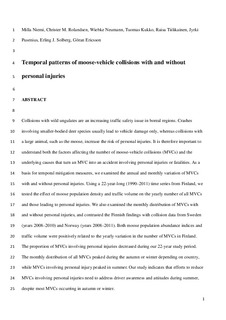Temporal patterns of moose-vehicle collisions with and without personal injuries
Niemi, Milla; Rolandsen, Christer Moe; Neumann, Wiebke; Kukko, Tuomas; Tiilikainen, Raisa; Pusenius, Jyrki; Solberg, Erling Johan; Ericsson, Göran
Journal article, Peer reviewed
Accepted version

Åpne
Permanent lenke
http://hdl.handle.net/11250/2456266Utgivelsesdato
2017Metadata
Vis full innførselSamlinger
- Publikasjoner fra CRIStin - NINA [2364]
- Scientific publications [1392]
Sammendrag
tCollisions with wild ungulates are an increasing traffic safety issue in boreal regions. Crashes involvingsmaller-bodied deer species usually lead to vehicle damage only, whereas collisions with a large animal,such as the moose, increase the risk of personal injuries. It is therefore important to understand boththe factors affecting the number of moose-vehicle collisions (MVCs) and the underlying causes thatturn an MVC into an accident involving personal injuries or fatalities. As a basis for temporal mitigationmeasures, we examined the annual and monthly variation of MVCs with and without personal injuries.Using a 22-year-long (1990–2011) time series from Finland, we tested the effect of moose populationdensity and traffic volume on the yearly number of all MVCs and those leading to personal injuries. Wealso examined the monthly distribution of MVCs with and without personal injuries, and contrasted theFinnish findings with collision data from Sweden (years 2008–2010) and Norway (years 2008–2011). Bothmoose population abundance indices and traffic volume were positively related to the yearly variationin the number of MVCs in Finland. The proportion of MVCs involving personal injuries decreased duringour 22-year study period. The monthly distribution of all MVCs peaked during the autumn or winterdepending on country, while MVCs involving personal injury peaked in summer. Our study indicatesthat efforts to reduce MVCs involving personal injuries need to address driver awareness and attitudesduring summer, despite most MVCs occurring in autumn or winter.© 2016 Elsevier Ltd. All rights reserved Animal-vehicle collision, Traffic safety, Population management, Mitigation measures, Injury risk, Deer